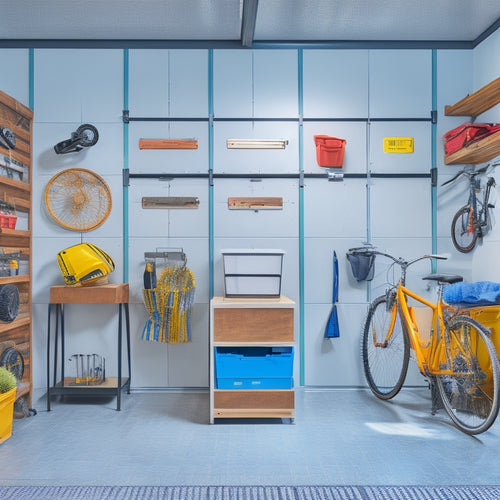
Efficient Woodworking: 5 Workflow Hacks to Boost Productivity
Share
You're tired of wasting time and money due to inefficient woodworking workflows. To boost productivity, you need to streamline your tool organization by implementing a storage system based on function and frequency of use. Optimize your workspace layout by designing work, material, and support zones for efficient workflow. Master task segmentation by breaking down projects into manageable tasks and prioritize them based on complexity, urgency, and dependencies. Eliminate time-wasting changes by implementing a station-based workflow and grouping similar tasks together. Finally, implement a maintenance schedule to reduce downtime. By implementing these hacks, you'll be on your way to a more efficient workflow - and that's just the starting point for accessing your full productivity potential.
Key Takeaways
• Organize your toolbox by function and frequency of use to reduce lost productivity and increase efficiency.
• Design a workspace with designated zones for work, materials, and support to optimize workflow and reduce walking distances.
• Break down projects into manageable tasks, prioritizing complexity, urgency, and dependencies to increase focus and accuracy.
• Eliminate time-wasting transitions by implementing a station-based workflow, grouping similar tasks, and preparing workpieces in advance.
• Implement a regular maintenance schedule to reduce downtime, clean and lubricate tools, and prevent costly repairs.
Streamline Your Tool Organization
Your workshop's efficiency relies heavily on quick access to the right tools, making a well-arranged toolbox an important aspect of a streamlined woodworking workflow. A messy toolbox can lead to wasted time searching for tools, which translates to lost productivity. To avoid this, implement a tool storage system that categorizes and separates tools based on their function and frequency of use. This will enable you to quickly locate the tools you need, when you need them.
A well-designed organization system should also consider the physical layout of your toolbox. Consider using dividers, bins, and hooks to maximize storage capacity and keep similar tools together. Label each section and compartment to make sure you can easily identify where each tool is stored.
Optimize Your Workspace Layout
With your tools organized and easily accessible, it's time to focus on arranging your workspace to maximize efficiency, ensuring that each project phase flows seamlessly into the next. A well-designed workspace layout is essential for ergonomic design, tool accessibility, and workflow efficiency. Consider the following layout principles to optimize your space utilization:
| Zone | Description | Key Considerations |
|---|---|---|
| Work Zone | Primary work area for tasks | Proximity to tools, comfortable standing/sitting |
| Material Zone | Storage for materials and supplies | Easy access, organized storage |
| Support Zone | Area for secondary tasks, such as measuring | Ample counter space, tool accessibility |
Master the Art of Task Segmentation
By dividing your woodworking projects into smaller, manageable tasks, you'll be able to tackle each phase with increased focus and precision. This task segmentation approach allows you to break down complex projects into bite-sized chunks, making it easier to allocate your time and resources effectively.
With a clear understanding of the tasks involved, you can prioritize them based on their complexity, urgency, and dependencies. This task prioritization enables you to allocate your time wisely, ensuring that you're tackling the most critical tasks first.
Effective time management is critical in woodworking, where small delays can add up quickly. By segmenting your tasks, you can create a schedule that's realistic and achievable. You'll be able to allocate specific time slots for each task, allowing you to work efficiently and make the most of your available time.
Additionally, task segmentation helps you identify potential bottlenecks and areas for improvement, enabling you to refine your workflow and boost your overall productivity. By mastering the art of task segmentation, you'll be able to complete your woodworking projects faster, with greater accuracy, and to a higher standard.
Eliminate Time-Wasting Transitions
Shifting between tasks can consume a significant portion of your woodworking time, especially when you're constantly switching between tools, stations, or workpieces. To eliminate these time-wasting handovers, you need to optimize your workflow. Here are some time-saving techniques to help you do just that:
| Inefficient Handover | Productivity Hack |
|---|---|
| Walking back and forth between tools | Station-based workflow: Organize your tools and materials around specific tasks to reduce walking distances |
| Switching between workpieces | Batch processing: Group similar tasks together to minimize setup and teardown times |
| Searching for misplaced tools | Designated tool storage: Assign a specific place for each tool to reduce searching time |
| Adjusting workpiece orientation | Pre-orient workpieces: Prepare workpieces in advance to reduce adjustment time during the task |
Implement a Maintenance Schedule
Regular maintenance is the unsung hero of woodworking, as it enables your tools and equipment to perform at their best, reducing downtime and increasing overall productivity. By implementing a maintenance schedule, you'll guarantee that your equipment is always in top condition, allowing you to focus on the task at hand.
You should start by scheduling routine inspections for your tools and equipment. During these inspections, take the time to clean and lubricate moving parts, as well as check for any signs of wear or damage. This will help prevent unexpected breakdowns and allow you to address any issues before they become major problems.
In addition to routine inspections, you should also take preventive measures to avoid costly repairs down the line. For example, regularly sharpening your blades and Bits will help extend their lifespan and improve their performance.
Frequently Asked Questions
How Do I Prevent Woodworkers' Fatigue and Injury in the Long Run?
You'll prevent woodworkers' fatigue and injury by setting up an ergonomic workspace, using proper tool techniques, and taking regular breaks to stretch and rehydrate, ensuring a safe and healthy working environment.
Can I Apply These Workflow Hacks to Small Woodworking Projects?
You're wondering if these workflow hacks are only for large-scale projects, but trust us, they're scalable! By applying time management and project organization strategies, you'll see benefits in small projects too, and tool maintenance and workspace optimization will save you time and energy.
Do I Need to Invest in New Tools for Efficient Woodworking?
You don't necessarily need new tools for efficient woodworking; instead, focus on tool maintenance, budget considerations, and developing your skills to optimize your workflow, and manage your time effectively to achieve productivity.
How Do I Handle Unexpected Project Interruptions and Setbacks?
When faced with unexpected project interruptions, you'll need to adjust your time management skills, employing coping strategies like prioritization and task re-allocation to minimize delays, while utilizing problem-solving and adaptability techniques to find creative solutions.
Are There Any Efficient Woodworking Techniques for Beginners?
When starting woodworking, you'll benefit from mastering basic safety tips, like wearing protective gear and keeping a clean workspace. Regular tool maintenance, such as sharpening and lubricating, will also help you work more efficiently.
Related Posts
-

3 Pro Garage Organization Ideas to Try Now
You can alter your garage from cluttered chaos to organized oasis with three pro garage organization ideas. First, op...
-

Small Shelving Options for Tight Spaces
You're surrounded by tight spaces in your home, and you need clever shelving solutions that optimize storage without ...
-

Creative Workshop Storage Solutions and Ideas
You can revolutionize your workshop's storage by maximizing vertical space with wall-mounted racks, utilizing hidden ...


